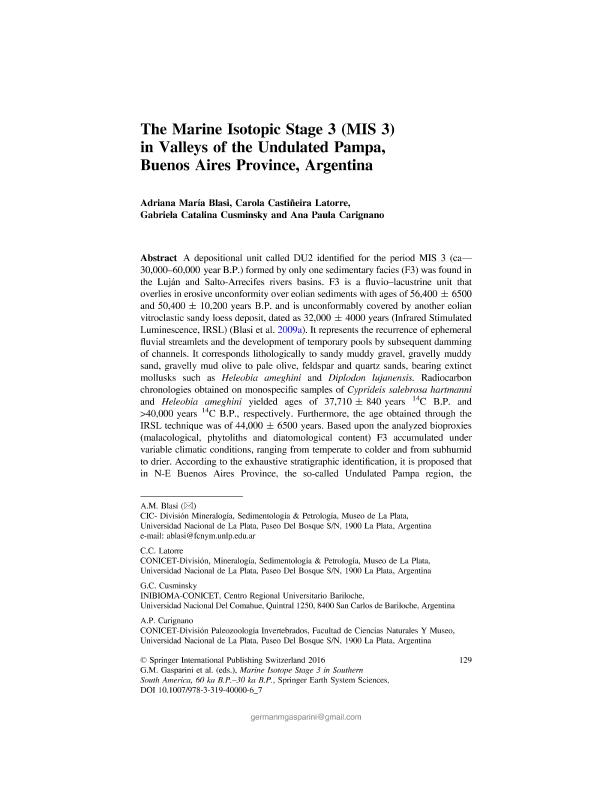Mostrar el registro sencillo del ítem
dc.contributor.author
Blasi, Adriana María
dc.contributor.author
Castiñeira Latorre, Carola

dc.contributor.author
Cusminsky, Gabriela Catalina

dc.contributor.author
Carignano, Ana Paula

dc.date.available
2018-08-13T18:58:17Z
dc.date.issued
2016-12
dc.identifier.citation
Blasi, Adriana María; Castiñeira Latorre, Carola; Cusminsky, Gabriela Catalina; Carignano, Ana Paula; The Marine Isotopic Stage 3 (MIS 3) in Valleys of the Undulated Pampa, Buenos Aires Province, Argentina; Springer; Springer Earth System Sciences; 12-2016; 129-146
dc.identifier.isbn
978-3-319-40000-6
dc.identifier.issn
2197-960X
dc.identifier.uri
http://hdl.handle.net/11336/55195
dc.description.abstract
A depositional unit called DU2 identified for the period MIS 3 (ca- 30,000-60,000 yr. B.P.) formed by only one sedimentary facies (F3) was found in the Luján and Salto-Arrecifes rivers basins. F3 is a fluvio?lacustrine unit that overlies in erosive unconformity over eolian sediments with ages of 56,400 ± 6,500 and 50,400 ± 10,200 years B.A. and is unconformably covered by another eolian vitroclastic sandy loess deposit, dated as 32,000 ±4,000 years (Infrared Stimulated Luminescence, IRSL) (Blasi, et al. 2010). It represents the recurrence of ephemeral fluvial streamlets and the development of temporary pools by subsequent damming of channels. It corresponds lithologically to sandy muddy gravel, gravelly muddy sand, gravelly mud, olive to pale olive feldspar and quartz sands, bearing extinct mollusks such as Heleobia ameghini and Diplodon lujanensis. Radiocarbon chronologies obtained on monospecific samples of Cyprideis salebrosa hartmanni and Heleobia ameghini yielded ages of 37,710 ± 840 years 14C B.P. and >40,000 years 14C B.P., respectively. Furthermore, the age obtained through the IRSL technique was of 44,000 ± 6,500 years. Based upon the analyzed bioproxies (malacological, phytoliths and diatomological content) F3 accumulated under variable climatic conditions, ranging from temperate to colder and from subhumid to drier. According to the exhaustive stratigraphic identification, it is proposed that in NE Buenos Aires Province, the so-called Undulated Pampa region, the sediments that were accumulated during MIS3 occur only in the central portion of the studied fluvial basins. This prompted two hypotheses related to the existence of a particular drainage pattern for the Late Pleistocene, different from the present one, and subsequent tectonic controls that allowed the identification of DU2 sediments only in some of the analyzed sections.
dc.format
application/pdf
dc.language.iso
eng
dc.publisher
Springer

dc.rights
info:eu-repo/semantics/openAccess
dc.rights.uri
https://creativecommons.org/licenses/by-nc-sa/2.5/ar/
dc.subject
Undulated Pampa Region
dc.subject
Buenos Aires Province
dc.subject
Mis 3
dc.subject
Late Pleistocene
dc.subject
Infrared Stimulated Luminescence
dc.subject
Paleoenvironment Reconstruction
dc.subject
Paleoclimatic Conditions
dc.subject
Fluvial And Lacustrine Sedimentation
dc.subject
Lujän River
dc.subject
Salto-Arrecifes Rivers
dc.subject
Analysis of Proxy Records
dc.subject.classification
Meteorología y Ciencias Atmosféricas

dc.subject.classification
Ciencias de la Tierra y relacionadas con el Medio Ambiente

dc.subject.classification
CIENCIAS NATURALES Y EXACTAS

dc.title
The Marine Isotopic Stage 3 (MIS 3) in Valleys of the Undulated Pampa, Buenos Aires Province, Argentina
dc.type
info:eu-repo/semantics/article
dc.type
info:ar-repo/semantics/artículo
dc.type
info:eu-repo/semantics/publishedVersion
dc.date.updated
2018-08-13T14:38:01Z
dc.identifier.eissn
2197-9596
dc.journal.pagination
129-146
dc.journal.pais
Alemania

dc.journal.ciudad
Berlín
dc.description.fil
Fil: Blasi, Adriana María. Universidad Nacional de la Plata. Facultad de Ciencias Naturales y Museo. División Mineralogía y Petrología; Argentina. Provincia de Buenos Aires. Gobernación. Comisión de Investigaciones Científicas; Argentina
dc.description.fil
Fil: Castiñeira Latorre, Carola. Consejo Nacional de Investigaciones Científicas y Técnicas. Centro Científico Tecnológico Conicet - La Plata; Argentina. Universidad Nacional de la Plata. Facultad de Ciencias Naturales y Museo. División Mineralogía y Petrología; Argentina
dc.description.fil
Fil: Cusminsky, Gabriela Catalina. Consejo Nacional de Investigaciones Científicas y Técnicas. Centro Científico Tecnológico Conicet - Patagonia Norte. Instituto de Investigaciones en Biodiversidad y Medioambiente. Universidad Nacional del Comahue. Centro Regional Universidad Bariloche. Instituto de Investigaciones en Biodiversidad y Medioambiente; Argentina
dc.description.fil
Fil: Carignano, Ana Paula. Consejo Nacional de Investigaciones Científicas y Técnicas. Centro Científico Tecnológico Conicet - La Plata; Argentina. Universidad Nacional de La Plata. Facultad de Ciencias Naturales y Museo. División Paleozoología Invertebrados; Argentina
dc.journal.title
Springer Earth System Sciences
dc.relation.alternativeid
info:eu-repo/semantics/altIdentifier/url/https://link.springer.com/chapter/10.1007/978-3-319-40000-6_7
dc.relation.alternativeid
info:eu-repo/semantics/altIdentifier/doi/http://dx.doi.org/10.1007/978-3-319-40000-6_7
Archivos asociados
